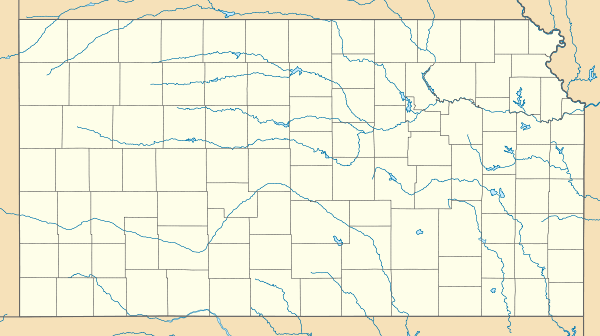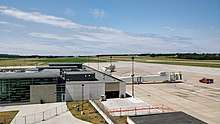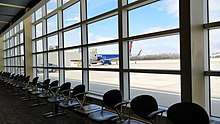Manhattan Regional Airport
Manhattan Regional Airport (IATA: MHK, ICAO: KMHK, FAA LID: MHK) in Riley County, Kansas is the second-busiest commercial airport in Kansas.[2] It is owned by the city of Manhattan, Kansas, and is about five miles southwest of downtown Manhattan.[1] American Airlines serves the airport with five daily flights to Chicago O'Hare International Airport and Dallas/Fort Worth International Airport. The airport is also used for general aviation and for planes chartered by the military and college sports teams (the airport is four miles east of Fort Riley and eight miles southwest of Kansas State University's athletic complex).
Manhattan Regional Airport | |||||||||||||||
|---|---|---|---|---|---|---|---|---|---|---|---|---|---|---|---|
 | |||||||||||||||
| Summary | |||||||||||||||
| Airport type | Public | ||||||||||||||
| Owner | City of Manhattan | ||||||||||||||
| Serves | Manhattan, Kansas | ||||||||||||||
| Elevation AMSL | 1,066 ft / 325 m | ||||||||||||||
| Coordinates | 39°08′28″N 096°40′18″W | ||||||||||||||
| Website | FlyMHK.com | ||||||||||||||
| Map | |||||||||||||||
 MHK  MHK | |||||||||||||||
| Runways | |||||||||||||||
| |||||||||||||||
| Statistics (2018) | |||||||||||||||
| |||||||||||||||
The National Plan of Integrated Airport Systems for 2013–2017 categorized it as a primary commercial service airport (more than 10,000 enplanements per year).
Traffic at the airport multiplied after American Eagle began its service in August 2009. Between 2008 and 2012, Federal Aviation Administration records show that annual passenger boardings (enplanements) at the airport grew from 16,489 to more than 69,000.[3][4] The most recent statistics show 70,705 enplanements in 2018.[2]
Facilities
Manhattan Regional Airport covers 680 acres (275 ha) at an elevation of 1,066 feet (325 m).[1]
In 2017 the airport had 24,260 aircraft operations: 81% general aviation, 4% airline, 9% air taxi and 6% military. 42 aircraft were then based at this airport: 33 single-engine, 7 multi-engine and 2 jet.[1]
The airport has two concrete runways: 3/21 is 7,000 by 150 feet (2,134 x 46 m) and 13/31 is 5,000 by 75 feet (1,524 x 23 m).[1] There are five taxiways and two parking aprons; they can support aircraft as large as the Boeing 767 or C-17.
Three navigation systems and multiple lighting systems guide aircraft; an FAA control tower and two Aircraft Rescue and Fire-Fighting (ARFF) vehicles round out the airside support. Any aircraft with 30 passenger seats or more, or over 110,000 lb (50,000 kg) landing weight requires prior permission from the Airport Director to land. Aircraft as large as the Boeing 767 land occasionally as charters for the military or sports teams.

Services
The first phase of the airport's new 42,000-square-foot (3,900 m2) terminal facility opened in March 2015, housing American Airlines, Hertz Rent-a-Car, Enterprise Car Rental, and other services. The expanded facility includes two gates, an expanded TSA security checkpoint, and additional passenger circulation space. There are also accommodations for a future airport restaurant. The terminal replaces a 11,700-square-foot (1,090 m2) terminal opened in 1997, which was demolished and replaced due to increased commercial airline traffic. The terminal is located at 5500 Skyway Drive, adjacent to the FAA control tower and FBO.

The FBO facility, next to the passenger terminal, is occupied by Kansas Air Center, which has been operating at the Manhattan airport since May 1989. It is a full service FBO, providing fuel, charter service, flight instruction, aircraft rental and management services.
An older 4,100-square-foot (380 m2) terminal building built in 1958 is now home to the airport administrative offices. This facility is at 1725 South Airport Road, 1 mile (2 km) east of the passenger terminal.
Heartland Aviation uses an 8,000-square-foot (700 m2) stone maintenance hangar, constructed in 1940, next to the old terminal building for servicing and repairing aircraft. The Kansas State University Flying Club, an airport tenant for over 50 years, has office space in this facility for instruction and flight planning.
Other facilities include a fire station, 48 hangars, storage areas, a fuel farm, and an air traffic control tower.
The airport has free parking next to the passenger terminal.[5]
Airline and destinations

| Airlines | Destinations |
|---|---|
| American Eagle | Chicago–O'Hare, Dallas/Fort Worth |
| Destinations map |
|---|
Destinations from Joplin Regional Airport |
Statistics
| Carrier | Passengers (arriving and departing) |
|---|---|
| Envoy Air | 88,800(63.36%) |
| ExpressJet | 51,180(36.52%) |
| Skywest | 170(0.12%) |
| Rank | Airport name | Passengers | Airline |
|---|---|---|---|
| 1 | Dallas/Fort Worth | 43,130 | American |
| 2 | Chicago O'Hare | 26,160 | American |
History
On June 13, 1939, construction began with the planting of temporary grass runways. The facility was dedicated in November 1940. The first "Manhattan Municipal Airport" terminal was dedicated on April 19, 1953, with U.S. Senator Frank Carlson giving a speech. Continental Airlines DC-3 flights began that month.
The current airline terminal opened in two phases between 2015-2016, replacing the 1997 terminal. The $18 million project has three jet bridge parking positions from two gates, and can accommodate aircraft as large as the Boeing 737 or Airbus A320. The new terminal has more space for ticketing, baggage claim, car rental, and security screening. There is space for a restaurant, but as of August 2017 a tenant has not been found.
Since the 1950s a number of airlines have served Manhattan Regional Airport.

Service history
- Continental Airlines
The first scheduled airline at Manhattan was Continental Airlines, which began DC-3 flights to Wichita in April 1953.[7] Continental pulled out in 1961, replaced by Central.
- Capital Air Service
Capital Air Service, Inc. (ICAO airline designator CPX), was headquartered in Manhattan from the 1960s until the company ceased flights in 1989, after having twice been grounded by the FAA for multiple safety and records keeping violations. Capital Air provided point-to-point air service to cities throughout northeastern Kansas.
In the 1970s Capital Air, an air taxi service, suffered two crashes, one with fatalities. In the 1980s one of its aircraft was tipped over by a gust of wind while waiting for take off clearance, and another aircraft, a Twin Otter, clipped the side of a terminal building, both incidents occurring at Kansas City International Airport.
At its height Capital Air served Manhattan; Salina, KS (SLN); Topeka, KS (FOE); Lawrence, KS (LWC); and Kansas City, MO (MCI) using two 20-passenger de Havilland Canada Twin Otters and smaller piston-engine aircraft.
- Frontier Airlines
Starting when it merged with Central Airlines in 1967, the original Frontier Airlines flew from Manhattan to Salina; Topeka (FOE); Wichita (ICT); and Kansas City on 44-seat Convair CV580s. By the early 1980s Frontier's Convairs were gone, replaced with a single daily non-stop Boeing 737 to Denver (DEN) that ended in at the beginning of 1983.
- Air Midwest
From the mid-1980s through the early 1990s, before its sale to Mesa Air Group in 1991, Wichita-based Air Midwest flew Manhattan to Salina and Kansas City on 19-passenger Fairchild Metroliner IIIs.
For several years in the mid-1980s Air Midwest was an Eastern Air Lines affiliate and flew 30-passenger Saab 340As in Eastern paint to Kansas City.
When Eastern closed its hub at Kansas City, Air Midwest sold their Saabs and signed a new codeshare agreement with the second incarnation of Braniff Airlines, which had started a small hub at MCI, and began flights to Kansas City on Fairchild Metroliner IIIs.
- Mesa Air Group
In 1991 Air Midwest was sold to the Mesa Air Group of Nevada. Subsequently, Air Midwest (a Mesa Air Group subsidiary), acting under a codeshare agreement with U.S. Airways and operating as US Airways Express, served Kansas City, Missouri from Manhattan, Kansas with three daily flights using 19-passenger Beechcraft 1900D turboprop aircraft.[8] The service ended with Air Midwest's bankruptcy in 2008, when all Essential Air Service contracts and flights operated by Mesa were closed.
- Great Lakes Airlines
Great Lakes Airlines flew to Manhattan between March 30, 2008, and April 7, 2010, taking over after Mesa left and ending service after American Eagle announced additional expansion. There were three daily flights, most days to Kansas City, and initially two daily flights (with one stop) to Denver. The flights to Denver were later cut back to once daily. Great Lakes used Beech 1900Ds.
- Allegiant Air
Allegiant Air operated a short-lived service of twice-weekly flights between Manhattan and Phoenix–Mesa Gateway Airport from November 7, 2013, to February 23, 2014.
- American Eagle
American Eagle flies to ORD and DFW. Flights to DFW are on Skywest Airlines Bombardier CRJ700 series and by Envoy Air on Embraer ERJ-140s. Flights to ORD are on Envoy Air ERJ-140s.
Accidents and incidents
- On May 28, 1963 a Lockheed L-1049 Super Constellation operated by Standard Airways suffered a failed propeller and crash landed at the Manhattan airport. All seventy passengers and crew escaped from the plane.
- On March 16, 1980, a commuter plane departing from the Manhattan airport lost a wheel from its landing gear immediately after take-off. The plane circled the Manhattan airport for ninety minutes to burn fuel, before safely landing in Manhattan in a shower of sparks.
References
- FAA Airport Master Record for MHK (Form 5010 PDF). Federal Aviation Administration. effective July 24, 2014.
- "Record number of people fly MHK in 2018". City of Manhattan. January 10, 2019.
- "Enplanements for CY 2008" (PDF, 1.0 MB). Federal Aviation Administration. December 18, 2009.
- "Enplanements for CY 2012" (PDF). Federal Aviation Administration. October 30, 2013.
- "Parking | Manhattan Regional Airport, KS - Official Website". www.flymhk.com. Retrieved 2019-09-30.
- "Manhattan/Ft. Riley, KS: Manhattan Regional (MHK)". Bureau of Transportation Statistics (BTS), Research and Innovative Technology Administration (RITA), U.S. Department of Transportation. December 2018. Retrieved 12 January 2019.
- http://specialcollections.wichita.edu/collections/local_history/tihen/pdf/eagle/Eag1953.pdf
- Air Midwest Adds Flights Retrieved on 2009-05-01
Other sources
- Reuters/American Airlines press release
- Essential Air Service documents (Docket DOT-OST-2003-15483) from the U.S. Department of Transportation:
- Order 2004-2-14 (February 17, 2004): selects Air Midwest, Inc., a wholly owned subsidiary of Mesa Air Group, Inc., d/b/a US Airways Express, to provide subsidized essential air service (EAS) for a two-year period at Manhattan and Salina, Kansas, at a combined annual subsidy rate of $721,605.
- Order 2006-3-15 (March 15, 2006): re-selecting Air Midwest, Inc., a wholly owned subsidiary of Mesa Air Group, Inc., d/b/a US Airways Express, to provide subsidized essential air service (EAS) for the two-year period beginning March 1, 2006, at Manhattan and Salina, Kansas, at a combined annual subsidy rate of $974,008.
- Order 2007-12-25 (December 21, 2007): re-selecting Air Midwest, Inc., a wholly owned subsidiary of Mesa Air Group, Inc., d/b/a US Airways Express to provide subsidized essential air service (EAS) at Manhattan and Salina, Kansas, for a total annual subsidy of $1,619,566 for the two-year period beginning March 1, 2008.
- Order 2008-2-5 (February 1, 2008): prohibiting Air Midwest, Inc. a wholly owned subsidiary of Mesa Air Group, Inc., d/b/a US Airways Express from suspending its subsidized essential air services at Manhattan and Salina, Kansas, until Great Lakes Aviation, Ltd. begins full replacement service, and selecting Great Lakes to provide those services for a new two-year period at an annual subsidy rate of $1,997,237.
- Order 2009-11-25 (November 30, 2009): requesting proposals from carriers interested in providing essential air service (EAS) at Salina, Kansas, for the two-year period beginning April 1, 2010, with or without subsidy. With respect to this order, we are soliciting proposals for service to Salina only. In the past, the communities of Salina and Manhattan were handled under the same contract because the flights were historically routed Salina-Manhattan-Kansas City. However, on or about August 26, 2009, American Eagle inaugurated subsidy-free regional jet service from Dallas-Fort Worth to Manhattan. American Eagle provides two daily nonstop round trips in the Manhattan-Dallas-Fort Worth market with 50-seat Embraer ERJ-145 regional jets on a subsidy-free basis. That level of service fully meets Manhattan’s EAS requirements, so, consistent with longstanding program practice, we will simply rely on American Eagle’s subsidy-free service and not request proposals. Despite not receiving an EAS subsidy, Manhattan will remain in the EAS program, and, should American Eagle subsequently decide to file a notice to leave, the Department would initiate a carrier-replacement proceeding by issuing an order holding in American Eagle and requesting proposals for replacement service from all interested carriers.
External links
- Manhattan Regional Airport (MHK), official site
- Manhattan Regional Airport at GlobalSecurity.org
- "Airport diagram and aerial photo" (PDF). from Kansas DOT Airport Directory
- Aerial image as of October 1991 from USGS The National Map
- FAA Airport Diagram for Manhattan Regional Airport (MHK) (PDF), effective July 16, 2020
- FAA Terminal Procedures for Manhattan Regional Airport (MHK), effective July 16, 2020
- Resources for this airport:
- FAA airport information for MHK
- AirNav airport information for KMHK
- ASN accident history for MHK
- FlightAware airport information and live flight tracker
- NOAA/NWS weather observations: current, past three days
- SkyVector aeronautical chart, Terminal Procedures